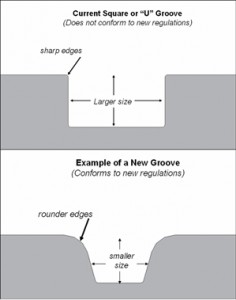 Not that this should come as any surprise, but the USGA’s upcoming groove change rule is being met with a wide variety of responses. Some people have already accepted the fate and begun to adjust accordingly, some are fighting it, hoping the rule gets reversed, and others, golf manufacturers mostly, are trying to find ways around the rule so they can continue down their already trodden paths. To this, the USGA has one thing to say, and they’re saying it by making amendments to their groove change rule, what they call “Further clarifying”: Stop Trying.
Not that this should come as any surprise, but the USGA’s upcoming groove change rule is being met with a wide variety of responses. Some people have already accepted the fate and begun to adjust accordingly, some are fighting it, hoping the rule gets reversed, and others, golf manufacturers mostly, are trying to find ways around the rule so they can continue down their already trodden paths. To this, the USGA has one thing to say, and they’re saying it by making amendments to their groove change rule, what they call “Further clarifying”: Stop Trying.
USGA’s Original Rule
That’s right, the USGA’s original wording for the rule was this:
“Manufacturers are reminded of the intent of the new groove regulations as stated in the February 27, 2007 Notice to Manufacturers: The objective of this change is to limit the effectiveness of grooves on shots from the rough to the effect of a traditional V-groove design.”
To Clarify…
Now, however, manufacturers were trying to find a loophole that met the design specs, but still gave increased performance. Luckily for all you non-tech geniuses (myself included) Golf Digest sought to clarify how they are trying to beat it, and how the USGA will respond:
“So what does that mean? Let’s say a pro hits a 90-yard shot out of the rough with a current wedge and generates 10,000 rpms of spin and that spin would be reduced to 5,000 or 6,000 with the proposed 2010 groove. Then along comes a wedge design that incorporates a groove that conforms to the new USGA standard, but produces 7,000 to 8,000 rpms of spin from the same condition. The USGA will not deem such a club conforming, despite it meeting the technical threshold of the rule.”
Effectiveness, Not Shape Matters
Basically, in simple terms, the new rule is not in place to just change the way the golf club is made, it’s in place to change the effectiveness of the clubs. They aren’t demanding new grooves for the grooves sake, they are demanding new grooves because of the effectiveness of those grooves. Make sense? Now, the USGA is making sure everyone knows that it’s not just the design of the grooves on your golf club that matter, if the effectiveness isn’t affected, they are non-conforming.
How Will They Respond?
Interesting, and an important distinction. How will manufacturers respond? Honestly, I see no other way than just compliance. You?











